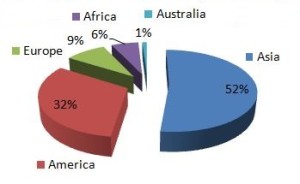The Impact of Biometrics in Banking
 The rapid digitization of banking services combined with the continued need to adopt stricter customer and employee identification protocols to prevent identity theft and fraud has set the table for biometric identification technology to become an integral and strategic part of financial service security platforms. Acting as a strong authentication tool to help secure ATM, brick and mortar, and online transactions, biometrics in banking also helps to increase customer trust and improve brand reputation. The necessity for a stronger authentication solution became inevitable in banking services because of the growing pace of sophisticated transactional technology adoption along with the unfortunate rise in fraud and security breaches due to reliance on traditional security systems such as passwords.
The rapid digitization of banking services combined with the continued need to adopt stricter customer and employee identification protocols to prevent identity theft and fraud has set the table for biometric identification technology to become an integral and strategic part of financial service security platforms. Acting as a strong authentication tool to help secure ATM, brick and mortar, and online transactions, biometrics in banking also helps to increase customer trust and improve brand reputation. The necessity for a stronger authentication solution became inevitable in banking services because of the growing pace of sophisticated transactional technology adoption along with the unfortunate rise in fraud and security breaches due to reliance on traditional security systems such as passwords.
Biometric Technology in the Banking Sector
Biometrics are automated methods of recognizing customers through their biological characteristics and traits such as fingerprints, finger vein patterns, iris, and voice recognition. Biometric characteristics are unique for every individual and difficult to forge, which is why biometric verification and authentication is commonplace in immigration control, law enforcement, and forensic studies. Many banks worldwide are already using biometrics with their banking systems to authenticate employees and customers and among all banks utilizing biometrics, 52 percent are located in Asia. Japan has more than an estimated 15 million customers using biometric authentication for banking transactions. Banks in Mexico, South America, Africa, and the Middle East are also moving towards the use of biometric identification technology because of its popularity with consumers, and ability to offer more security than traditional personal identification numbers (PINs) and passwords.
Figures – Proportion of Banking Using Biometric in Different Continents

Different Ways to Use Biometrics in Banking
Biometric technology is slowly replacing traditional passwords and token-based electronic access, signature-based branch service access, and PIN-based access in mobile banking and at ATMs. Here are ways that banks can use biometric technology to improve banking services and better protect customer assets:
- Biometrics in Branch Banking–
Financial service institutions are using fingerprint and finger vein biometrics in banking for customer identification in their branches because these two biometric authentication methods deliver fast results that are suitable for the busiest branches of a bank. Moreover, finger print and finger vein systems are user friendly, easy to use and ensure reliable security. When customers visit branches they can be authenticated at the counter through fingerprint and finger vein biometric scanners that match the customer’s existing biometric template within the bank database, and after successful authentication, the customer will be allowed to move forward with their banking transactions.
- Biometrics in Banking ATMs
Using biometrics in banking ATMs is popular in developed countries and the adoption rate is growing significantly. There are two approaches for customer authentication in ATMs — a customer using only biometrics and a bank card or a PIN along with biometric authentication. Therefore, facial recognition, fingerprints, finger vein patterns and iris recognition are the most suitable in ATMs as these biological traits can be easily authenticated in this environment. Furthermore, these types of biometric modalities also have other advantages such as flexibility, compactness, and accuracy.
- Biometrics for Internet Banking
Many computers, laptops, and even smart phones already have webcams, microphones, and fingerprint scanners, offering flexibility for banks to easily adopt biometric authentication in online banking services with fingerprint, finger vein, facial, and voice recognition. When customers attempt to access their account, some banks now require them to provide a biometric credential first. Some banks require biometric authentication beside the traditional password to make authentication stronger, also known as a “multi-factor” authentication system. This helps banking institutions to protect customer identities from being compromised by cyber criminals and any others trying to illegally obtain sensitive customer information to commit a crime.
- Biometrics in Mobile Banking
Mobile banking is growing rapidly worldwide, and according to Juniper Research, 400 million people performed a mobile banking transaction in 2013. Despite this large number, many bank customers still have a lack of trust over the security of mobile banking platforms and concerns over security. Banking transactions or customer services could be performed through a voice or speech recognition system where customers need to verify their identity using the microphone in their phones.
- Single Sign on Solution for More Effective Password Management
Banks and financial institutions are suffering from network security and data breaches worldwide. According to a recent ACI Worldwide Survey, 44%of customer financial accounts have been compromised and 15% of breaches cause fraud. In a 2013 Ponemon Institute Survey, it was reported that an average cost of these types of incidents is $9.4 million. Banks can easily adopt biometric single sign on (SSO) solutions into their network for password management, identity management, data and network security, and two factor authentication. This system will eliminate vulnerable passwords and loopholes of a bank data security system and will protect both banks and customers from unauthorized access and data breaches. Furthermore, a biometric SSO system will mitigate other security risks and regulatory fines for government compliance.
Benefits of Using Biometrics in Banking
- Protecting Banking Information – Biometric technology provides the strongest method of authentication that protects banking information from being compromised by unauthorized personnel.
- Fast and Accurate Branch Banking – Biometric technology provides fast and accurate identification for the banking industry. Customers can be quickly authenticated in mere seconds through a fast biometric scan.
- Protection Against Insider Fraud – Biometric identification of employees performing transactions on the back end is a crucial step to ensuring identity protection and reducing fraud. Biometrics in banking will help financial institutions to prevent insider fraud by establishing secure employee authentication, accountability and concrete audit trail of each transaction.
- Secure Online Banking – Over the past years the banking sector has been suffering from massive online service cyber attacks. In most of these cases customers lose their money from the negative effects of identity theft. Biometrics in banking helps the bank to protect customer identities when using online banking services.
- ATMs with Biometrics – Biometrics in banking for ATMs authentication brings outstanding benefits to both customers and banks. This system now gives customers flexibility to make transactions without bringing bank cards. Banks can avoid the costs and liabilities of customer problems due to lost or stolen bank cards.
- Audit Trails – Banks can easily track and monitor employee and customer activity in the system to create concrete audit trails with biometric technology solutions.
- Fast, Secure and Accurate Customer Care Service – The banking sector is always in need of tighter security solutions to provide improved and more secure customer care service over the phone and internet. A biometric voice recognition system for example provides a secure and flexible solution to verify any customers executing transactions outside of a brick and mortar environment.
Conclusion
Due to the role of customer trust and loyalty in the success of banks, and thus in the economic development of countries, banks should provide convenient and more secured banking services to customers. Biometric technology, integrated with an existing traditional security system, will empower banks to deploy the highest level of authentication security possible.
This blog post was written by Arifin Hossain, Executive in our Business Development & Interactive Marketing Department













Pingback: Mobile Banking, Biometrics & Cloud are Changing Banking
Pingback: The Impact of Biometrics in Banking | Kenneth Carnesi
Pingback: Know Your Customer (KYC) with Biometrics
Pingback: Biometric Banking Technology Can Secure Transactions From Anywhere